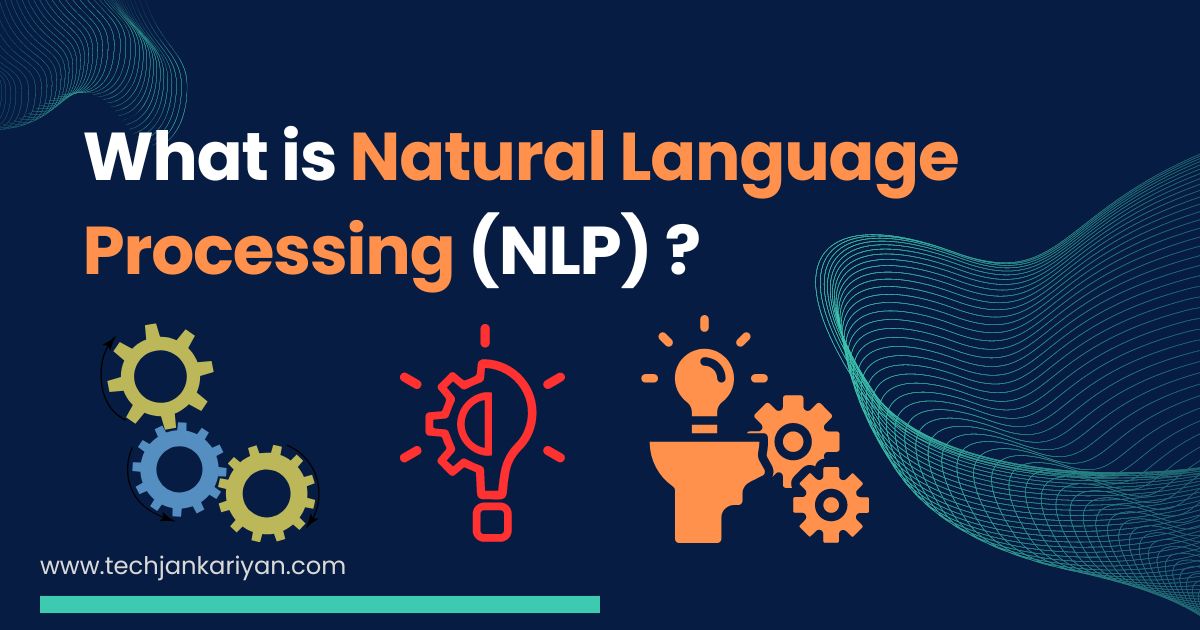There is a lot of unstructured data. Without the help of natural language processing (NLP), businesses cannot analyze and process this unstructured data.

What is NLP?
NLP stands for Natural Language Processing. It belongs to the fields of artificial intelligence (AI) and machine learning (ML). The goal of NLP is to enable computers to understand, interpret, and produce human language in a meaningful and useful way. This includes tasks such as sentiment analysis, language translation, and text classification.
How Does NLP Works?
NLP, or Natural Language Processing, is a field of artificial intelligence concerned with enabling computers to understand, interpret, and generate human language. NLP works by using a combination of algorithms and techniques to analyze and process language data.
The process of NLP involves several steps:
Tokenization: The input text is divided into individual words, phrases, or sentences, which are called tokens.
Parsing: The tokens are analyzed to determine their grammatical structure and relationships with each other. This is often done using techniques such as part-of-speech tagging and syntactic parsing.
Named Entity Recognition (NER): NER is used to identify and extract entities such as people, organizations, and locations from the text.
Sentiment Analysis: Sentiment analysis is used to determine the emotional tone of the text. This can be useful for analyzing customer feedback, social media posts, and other forms of user-generated content.
Machine Learning: NLP models can be trained on large datasets of language data to learn patterns and improve their accuracy in tasks such as text classification, machine translation, and question answering.
Overall, NLP works by breaking down language data into its component parts, analyzing those parts, and using that analysis to extract meaning and generate new language.
Importance and potential applications of NLP
NLP has become increasingly important in recent years due to the explosion of digital data and the need to extract meaningful insights from it. Here are some potential applications of NLP:
Text Classification: NLP can be used to classify text into categories such as spam or not spam, positive or negative sentiment, or topics such as sports, politics, and entertainment.
Sentiment Analysis: NLP can be used to determine the sentiment of text, such as customer feedback or social media posts. This can help businesses to understand customer opinions and improve their products and services.
Machine Translation: NLP can be used to translate text from one language to another. This is useful for businesses and individuals who need to communicate with people who speak different languages.
Chatbots: NLP can be used to develop chatbots that can understand and respond to natural language queries. This can be useful for customer service or support applications.
Speech Recognition: NLP can be used to convert spoken language into text, which is useful for applications such as voice-controlled assistants or transcribing spoken content.
Text Summarization: NLP can be used to automatically generate summaries of long documents or articles. This can be useful for researchers, journalists, or anyone who needs to quickly understand the main points of a large amount of text.
Named Entity Recognition: NLP can be used to identify and extract named entities such as people, organizations, and locations from text. This can be useful for applications such as information extraction or document analysis.
Overall, NLP has the potential to revolutionize the way we interact with language data and enable us to extract valuable insights and information from it.
Key Techniques in NLP
Natural Language Processing (NLP) involves the application of computational techniques to process and analyze human language. Here are some of the key techniques used in NLP:
Tokenization: This is the process of breaking down a text into individual words or tokens. It is an important first step in NLP because many algorithms and models rely on analyzing individual words.
Part-of-speech tagging: This involves identifying the part of speech (noun, verb, adjective, etc.) of each word in a text. This can help with tasks such as text classification and sentiment analysis.
Named entity recognition: This involves identifying and categorizing named entities in a text, such as people, organizations, and locations. It can be useful for tasks such as information extraction and text summarization.
Parsing: This involves analyzing the grammatical structure of a sentence, such as identifying the subject and predicate. It can be useful for tasks such as machine translation and question answering.
Sentiment analysis: This involves determining the sentiment or emotion expressed in a text, such as positive or negative. It can be useful for tasks such as social media monitoring and customer feedback analysis.
Topic modeling: This involves identifying the topics discussed in a collection of texts. It can be useful for tasks such as content analysis and trend detection.
Machine translation: This involves translating text from one language to another. It can be useful for tasks such as global communication and content localization.
Text summarization: This involves generating a brief summary of a longer text. It can be useful for tasks such as news aggregation and document summarization.
These techniques are often used in combination with each other to achieve more complex NLP tasks.
NLP Challenges
Despite the significant progress that has been made in Natural Language Processing (NLP) in recent years, there are still several challenges that researchers and practitioners face. Here are some of the key challenges in NLP:
Ambiguity: Human language is inherently ambiguous, and words can have multiple meanings depending on the context. This poses a challenge for NLP systems that must accurately interpret the meaning of a text.
Data quality: NLP systems require large amounts of high-quality data to train and perform well. However, data can be noisy, biased, or incomplete, which can affect the accuracy and reliability of NLP models.
Multilingualism: NLP systems must be able to process text in multiple languages. However, different languages have different linguistic features and structures, which can make it challenging to develop universal NLP models.
Understanding idioms and metaphors: Idioms and metaphors are common in human language but can be difficult for NLP systems to understand because their meanings are not always literal.
Contextual understanding: Understanding the context in which words and phrases are used is critical for accurate NLP. However, context can be complex and dynamic, which makes it challenging for NLP systems to accurately interpret meaning.
Ethics and bias: NLP systems can perpetuate bias or reinforce harmful stereotypes if not designed and trained appropriately. Ensuring ethical and unbiased NLP is an ongoing challenge for the field.
Continuous learning: NLP systems must be able to learn and adapt to new language patterns, trends, and vocabulary over time. This requires ongoing updates and retraining of NLP models, which can be resource-intensive.
Addressing these challenges is critical for the continued development and advancement of NLP, and researchers and practitioners are constantly working to improve NLP systems and overcome these obstacles.
Current Research and Future Directions
Natural Language Processing (NLP) is a rapidly evolving field, and researchers are continuously exploring new techniques and approaches to improve the accuracy and capabilities of NLP systems. Here are some of the current research areas and future directions in NLP:
Pretrained language models: Pretrained language models such as BERT, GPT-3, and T5 have shown remarkable performance in several NLP tasks. Researchers are exploring new ways to improve these models, such as making them more efficient and easier to fine-tune for specific tasks.
Multimodal NLP: NLP systems are increasingly being used to process not just text, but also other forms of data such as images and audio. Multimodal NLP involves developing models that can process and interpret these different modalities.
Explainable NLP: As NLP systems become more advanced and complex, it becomes increasingly important to understand how they arrive at their predictions and decisions. Explainable NLP involves developing models that can provide transparent and interpretable explanations for their outputs.
Cross-lingual NLP: As the world becomes more globalized, there is a growing need for NLP systems that can process and understand text in multiple languages. Cross-lingual NLP involves developing models that can transfer knowledge and understanding between different languages.
Interactive NLP: Interactive NLP involves developing systems that can engage in more natural and interactive conversations with humans. This requires models that can understand and respond to human emotions, context, and intent.
Social NLP: NLP systems are increasingly being used to analyze and understand social media data. Social NLP involves developing models that can process and interpret the nuances of social media language, such as slang, emojis, and hashtags.
Ethical and responsible NLP: As the use of NLP systems becomes more widespread, there is a growing need to ensure that they are designed and used in an ethical and responsible manner. This involves developing frameworks and guidelines for ethical and responsible NLP research and practice.
These are just a few of the many exciting areas of research and development in NLP. As the field continues to evolve, we can expect to see even more advances in the capabilities and applications of NLP systems.
Conclusion
In conclusion, Natural Language Processing (NLP) is a rapidly advancing field that has the potential to revolutionize the way we interact with technology and process human language. NLP techniques and applications are already being used in a wide range of fields, from healthcare and education to finance and entertainment.
However, there are still many challenges to be addressed in NLP, such as data quality, ambiguity, bias, and ethics. Researchers and practitioners are constantly working to improve NLP systems and overcome these obstacles, through approaches such as pretrained language models, multimodal NLP, and explainable NLP.
As we look to the future, it is clear that NLP will continue to play an increasingly important role in our lives, enabling more natural and seamless interactions with technology, and empowering us to process and understand human language in new and exciting ways.
Also Read :




